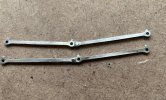Robert Dawson
Member
So, having finally overcome the belief that the best way to make brilliant models is to leave them in their box and with thanks to the encouragement I got from my introductory post, I finally took the plunge and have started my 4mm Finney Dean Goods. To my eye it’s a beautiful prototype, one that I just about managed to put together from a K’s kit about a hundred years ago, and a fabulous kit. I intend to model it with polished brass dome and all; round topped S4 boiler and Indian Red frames.
Work has begun, and the frames assembled reasonably sweetly. But now I’ve hit a possible problem with the connection between the two halves of the coupling rod. i consider myself reasonably nifty with a soldering iron but found soldering the pin that joins the two haves, without seizing the lot up, challenging until I hit on the late John Haynes suggestion to use cigarette paper in the joint. But Mr Finney then says to file the back flush. With the pin fitting nicely into the 1mm hole there seems little opportunity for solder to attach itself to anywhere other than the back. I have filed the pin down to a knat’s whisker of the surface but- and here’s the question to those much wiser than I- will I get away with it or will the tiniest projection foul the wheels (ultrascale)? If so, what is the best way- is there a magic solution? (I wish there always to be a magic solution…)

Work has begun, and the frames assembled reasonably sweetly. But now I’ve hit a possible problem with the connection between the two halves of the coupling rod. i consider myself reasonably nifty with a soldering iron but found soldering the pin that joins the two haves, without seizing the lot up, challenging until I hit on the late John Haynes suggestion to use cigarette paper in the joint. But Mr Finney then says to file the back flush. With the pin fitting nicely into the 1mm hole there seems little opportunity for solder to attach itself to anywhere other than the back. I have filed the pin down to a knat’s whisker of the surface but- and here’s the question to those much wiser than I- will I get away with it or will the tiniest projection foul the wheels (ultrascale)? If so, what is the best way- is there a magic solution? (I wish there always to be a magic solution…)

